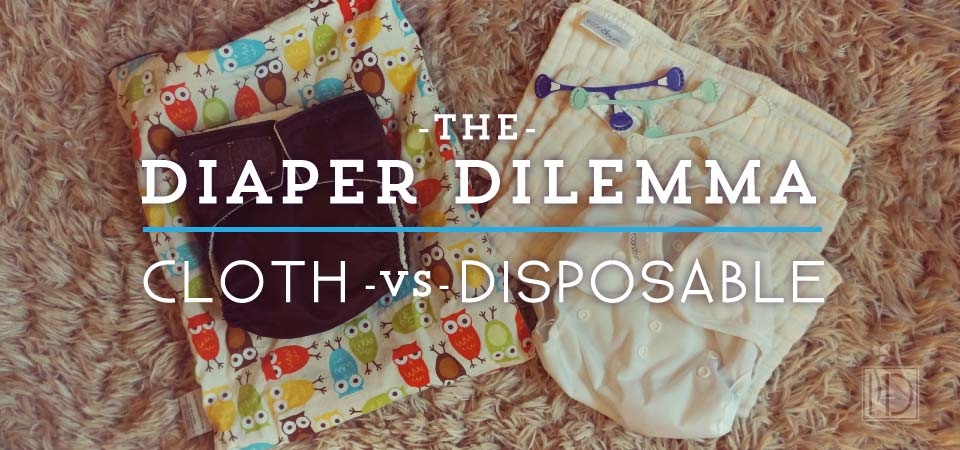 Of all the decisions we have to make as new moms, I thought diapering a baby would be an easy one. But, I got drawn into the cloth diapering/disposable debate.
Of all the decisions we have to make as new moms, I thought diapering a baby would be an easy one. But, I got drawn into the cloth diapering/disposable debate.
Cloth diapering has the allure of being environmentally friendly, easier on the budget, and better for baby. But figuring out how to get started with cloth diapering is overwhelming.
My life was too hectic to put in the research effort when I had my first child, and knowing I’d be back at work when he was a few months old, I opted to stick with disposables. For my second, I was a stay-at-home mom and had more flexibility to explore the options, so I decided to give cloth diapers a try. I also had support from several friends that had gone the cloth route who made it look easy.
The Pricey Options
Many cloth diapers are not what our grandmothers used. They are hardly even cloth at all, often coming with a waterproof shell and a soft microfiber inside with hemp, wool, or bamboo inserts. They come with cute names like BumGenius or FuzziBunz. The more I looked into these options, the less environmentally-friendly or cheap I found them. The all-in-one diapers often cost $25 or more each, requiring a huge initial investment. They also have to be washed in several different wash cycles because the material breaks down fairly easily if not washed properly, and the absorbency decreases with hard water build up. That process consumes far more water and electricity than I’m comfortable with. But I wasn’t ready to give up on the idea of going with the non-disposable route, so I looked into other options.
The Budget Options
The cheapest cloth diapers are pre-folds or flat diapers. Happily, you no longer have to use safety pins to secure them. They now make these nifty plastic fasteners called Snappis. The diaper needs a waterproof cover, but you can buy three or four and be in good shape because they can be reused several times before washing. These diapers don’t require special washing as long as you choose detergents like Charlie’s Soap that don’t reduce absorbency. It’s around $15 for over 100 loads.
My Decision
We are stationed in Germany with German washers and dryers. The shortest wash cycle I could use lasted over an hour, and the dryer would take two to three hours to get the diapers completely dry. I tried line drying but those pre-folds would NEVER get dry when I hung them outside. Finally, I purchased a dozen flat, unbleached cloth diapers for under $25. This was the most environmentally friendly, inexpensive option for me.
My Advice
Experiment before you invest. I put several options on my baby shower wish list. I received two all-in-one diapers of different brands, a wet sack, Snappis, and a starter box of Ecobum prefolds that came with three diaper covers. Had I purchased these on my own, the cost would have been around $100. I didn’t purchase anything else for my collection except for the flat folds I mentioned above. In addition to using Amazon, Kelly’s Closet is a great resource.
Give it some time. Cloth diapering takes some serious getting used to. You really do need to change diapers twice as often, otherwise you end up with a lot of leakage. I went through many wardrobe/bedding changes, mostly in the middle of the night. Also, the urine smell can get seriously intense even when you are washing the diapers almost daily.
Be flexible. In the end, my baby wore disposable diapers at night starting around three/four months old when he started sleeping longer stretches, whenever we left the house, and definitely when we traveled. My plan was to make it to the six-month mark when he started eating solids. This is the critical point where the poop becomes “real,” which translates into cleaning the poop off of the diapers rather than just tossing them into the wet pail.
Why it Worked for Us
Going the cloth diaper route was anything but glamorous. But, it was pretty fantastic when my baby was a newborn going through 12 or more diapers in a day because I never agonized about the waste or the cost as I changed his diaper.
I thought I would have given up by now, but I’m still going strong. Cloth-diapering became routine and using disposables occasionally helped.
In the end, I think about how much money I’ve saved our family, and the reduced impact we’ve had on the environment by going through only one package of diapers a month. I’ve saved about $35-40 a month on diapers, and at least double that amount during the first three months. I’m not sure what the energy cost is for doing the laundry, but I don’t use any special washing techniques. Most cloth diaper advocates wash their diapers “properly” using, at a minimum, a cold rinse, followed by a warm wash, and one extra rinse. If you are able to line dry the diapers this can also greatly reduce energy consumption. It’s difficult to calculate exactly how much you can save or the true cost of using disposables because there are so many choices and factors at play.
My hat goes off to my diaper warrior friends for being strong advocates for their cloth diaper alternatives, including many choices I haven’t mentioned here. Let me say though, I have zero judgment for those friends of mine that never considered, or opted out, of cloth diapering. It’s not for everybody. But, if you do want to give it a go, I encourage you to do it. I hope my story shows there are many ways that you can make the non-disposable option work for you.
Questions? Ask in the comments below.

